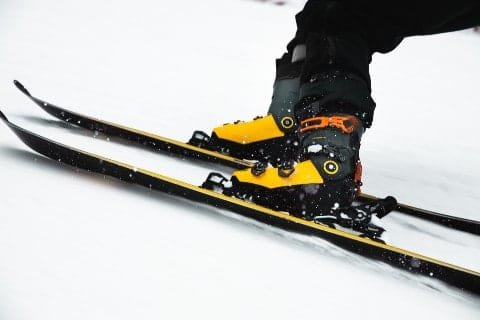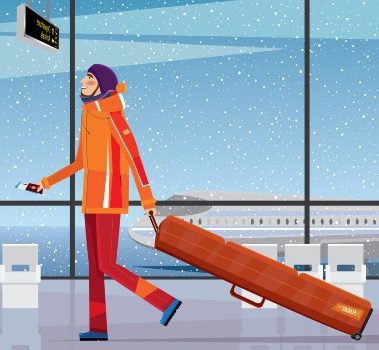Flying with skis is not something you can just do on a whim – it will take a little bit of planning, research, and investment. Regardless of which airline you’re flying with, you will need to invest in a ski bag for your travels to, at minimum, contain your equipment. You will also want to take a look at the specific requirements of travel (likely under sports equipment) for your airline to make your travel experience as smooth as possible. Then you’ll have to make some decisions on exactly how you want to pack your ski bag – as your sole piece of checked luggage or as a secondary piece of luggage.
If you want to learn more about the specifics on how to fly with skis, keep reading below.
Table of Contents
Can I Take My Skis on the Plane?
The general consensus is yes, most airlines will allow you to take your skis on the plane. Each airline will have its own policy, so if you have previously flown with skis on one airline, do not assume that the same rules apply. Most airports will allow a ski bag to be checked as luggage so long as the total weight of all your checked pieces is under 50 pounds. Of course, please do not show up to the airport with loose skis just tucked under your arm; that would be frowned upon and maybe not even an option for traveling.
Investing in the appropriate travel gear is very important to protect your ski equipment; you’ve already put an investment into purchasing your skis, ski poles, helmets, gloves, boots, and any other gear – you would not want to run the risk of damaging them for copping out on a cheap bag. This bag could also serve other purposes outside of simply traveling.
You can find cheap bags where the sole purpose is simply to contain your equipment; these bags would probably be best suited for closet storage at home, not for transport. You can find more affordable bags that hold and protect the basics that are your skis and ski poles. You could go the extra mile and invest in a luxury bag that can hold it all and then some. For the preservation of skis, many sports equipment companies will sell ski bags and ski boot bags separately.
Airlines ultimately have the final say in how your luggage is checked, but more often they will view your ski bag and boot bag as one uniform piece of luggage instead of two. This is not always the case, though, so be sure to check your airline’s policy to learn how to fly with skis.
How to Pack Skis for Flying
Your first step in packing your skis for flying is deciding on a bag. You do have a few options when it comes to actually packing your skis for flying. You may be trying to pack for the most cost-effective method – meaning that your ski bag for flying becomes your personal luggage for clothes, toiletries, and everything else. For this you may want to use something like a large duffle bag with a drop bottom compartment so that you can separate your clothes from your ski equipment.
On the other hand, you may be trying to pack by preparing for the worst – lost luggage. Whether you are looking for the more frugal option or the option that covers your bases, you will find everything you need to know here.
Take your time to do research on which bag you would like for your equipment. There are a lot of options out there and if this is your first time preparing for travel you should talk to friends who have had experience and seek out advice from professionals who do this for a living. Your bag can dictate how you pack the rest of your items. For your own sake, regardless of which bag you choose, be sure to label all equipment storage with your name and address just in case.
Packing Skis in a Single Ski Bag
If you choose a bag that is meant for just a single set of skis and ski poles, you may need to pack an extra piece of luggage for your clothing, other equipment, and your boots. There is nothing wrong with this option, but it just might not be the most cost-effective. The single ski bag is the most basic option and won’t have much room for bulking anything else in it. For some people, this is not an issue as they don’t want to run the risk of damaging their skis with non-ski equipment. But if you’re a savvy packer, this may not be the best option for you.
In using a single bag, you may want to invest in ski straps to make sure your skis do not slide around and scratch each other up or cause damage to your other luggage. This is not a requirement but a suggestion if you’re looking to keep your skis in prime condition. Another recommendation to preserve the integrity of your ski equipment is making sure to secure the ends of your poles with a softer material. Even if they were to slide around in your ski bag, having that protective covering will ensure they aren’t causing any unnecessary damage to your expensive equipment.
Packing Skis in an All-in-One Piece of Luggage
In a single skis bag, it isn’t likely that you’ll have room to lay your skis flat in the bottom of your bag and then pack things on top of them. If you upgrade to a double ski bag or large duffle for just your equipment, this will provide some extra room for you to make the most of your checked luggage. If you go this route, instead of using ski straps to secure your skis together by their bases, you can lay your skis down side by side and secure the brakes out of the way (with straps or rubber bands).
This method will keep your bag stiff once it is fully packed and keep things from sagging or shifting around too much. From there, you just pack the rest of what you need on top of your skis. It is recommended to be thoughtful about how you pack things – the things that are packed directly on top of your skis should not be rough or sharp as you want to protect them from excess wear whenever possible. If you have heavier items you are bringing, pack those at the bottom of the bag so there is less shifting as you walk through the airport.
Again, when you pack your polls, be sure to wrap a protective covering around the ends to prevent them from damaging your skis. This could also protect them from damaging your bag and other items you have packed as well.
Packing Ski Boots
As previously mentioned, you may want to pack all of your equipment together or you may want to pack it separately for several reasons. There is no right or wrong way to pack your boots; it is ultimately up to you! If you would like to pack your boots with your skis and poles, be sure that they are secure and are not going to cause wear and tear to your skis during travel. Boots are hard and durable but your skis aren’t; someone packing your equipment onto the plane may not be as gentle as you would.
Some ski bags come with their own boot compartments separate and some come with a completely separate bag for this purpose. Although the latter is technically two bags, some airlines will let you group them together to count as one piece of luggage (so long as their total weight does not exceed airline limits). Another reason you may want your ski boots packed separately is because lost luggage is a real thing. Skis, poles, and other basic equipment are easy to rent, but a good pair of fitted ski boots…well, not so much. It may be worth the extra hassle to pack them separately and even have them as your carry on solely for that purpose. Here are our recommended picks for a good ski boot bag for carry on.
Is it Worth it to Fly With Skis?
If you just ski leisurely (a couple of times a year), it probably isn’t worth the hassle or investment to fly with skis. If you ski regularly and have all of your own equipment, especially if it is custom made to fit you, then you’d be doing a disservice to yourself if you didn’t fly with your skis. If traveling stresses you out, flying with skis may just seem like one more thing to add to your plate and ultimately may not be worth it, but if you’re up for the challenge, why not?
How Much Does it Cost to Fly with Skis?
The short answer is, at minimum, flying with a pair of skis is about $30 one-way depending on the airline. Each airline will have its own policy, so it is important to do your research. Thankfully ski gear is often considered sporting equipment and does not classify as “oversized” luggage but will often be charged if overweight. If you pack your ski bag to serve as your luggage as well, then you are going to be flying with checked bag dimension restrictions just like for any other baggage. For most airlines, the first checked bag costs about $30 but can be as much as $50; these bags do have weight and length limits, however, so make sure you check each airline’s policy to make sure you don’t incur extra fees.
Most airlines will allow you to count your ski bag and your boot bag as one bag under sports equipment, so long as they are not packed with anything else. The weight limit for most airlines is 50 pounds for your first checked bag, but each airline does have its own specifics for this. The length range is a little more fluid for airlines. There are some airlines that will exempt skis and snowboards from the standard overall dimensions requirement (62 inches) and others will not, which will result in oversized fees.
If you have other luggage or equipment outside of this, they will charge for each additional bag. The biggest thing is to remember when traveling, especially if you have multiple checked bags, is that these fees are charged one-way. For roundtrip flights, this means your checked luggage will be charged on the way there and on the way back, so fees could add up quickly. Apart from those fees, many airports require you to book ahead of time and a later booking at the airport could result in more fees for your luggage.
If you’re still reading and not afraid yet from the intricate details that it takes to fly with skis, then here is a pointer for making flying with skis cheaper. If you get an airline-branded credit card, many of them have perks that make your first checked bag free; if you only require one checked bag, then you will never have extra fees so long as you follow weight and length requirements. Many ski trips involve more than one person and this perk can apply to up to nine people from certain airlines.
Which Airlines Allow Skis for Free?
Air Canada and Southwest Airlines allow skis for free.
Is it Cheaper to Rent Skis or Fly With Them?

Ultimately, it depends on what your intentions are for skiing. Do you plan on going for one day of skiing or are you making a trip of it, planning to stay at a lodge or resort and skiing for several days? If you only plan to ski for one day during your travels, it probably is not worth the time, planning, expense, and logistics of learning how to travel with skis. If you plan on skiing daily for an extended period of time, flying with your skis will be the cheapest option, even if you have to check two separate bags.
Ski rentals are affordable but those costs can quickly add up. Generally, renting skis includes the basic equipment required for skiing, meaning your poles and boots as well. Assuming you are planning to travel somewhere with the specific goal of skiing, you’ll likely be spending more than one day there.
Is it Cheaper to Ship Skis or Fly With Them?
Flying with skis, broken down above, could cost a minimum of $30 one-way and the maximum depends on each specific airline as well as the other luggage you may need to bring with you during your travels. If you’ve ever shipped anything in the world today, you can probably assume that it would hands down be cheapest to fly with them, even if there was a little hassle.
If you were to ship your skis, you would need to make sure they were packaged well for protection. Finding a box and packing materials is only one cost; the biggest expense is actually shipping them. You can use Ship Skis to ship your skis for as low as $39 for ground shipping. If you go through a regular shipping company (USPS, FedEx, etc.) skis will be considered an oversized package and fees will automatically be applied. You can see prices for as much as $150 after packaging is added on.
To Ship, to Rent, or to Fly?
Shipping may provide the most protection for your personal gear if you purchase insurance on it, but ultimately the planning for actually shipping it and the fees would be the least cost-effective. You would have to communicate with the location where you would be shipping them (a family member, a lodge, or resort) and also plan for the amount of time it would take for delivery, potentially even accounting for shipping delays. There are just so many unknowns when it comes to shipping that it is probably the least reasonable option.
When it comes to renting, this will ensure that you have all of the gear necessary and don’t have to fight the logistics of traveling with that bulky gear but there are a few things to consider. If you ski regularly and have your own gear, then your gear is likely personalized to you and you are used to how it handles. Renting gear could affect your efficiency while skiing and they may not have exactly the right lengths for your needs. Renting gear will ensure that you can have many options for the different snow conditions, though.
Ultimately, flying with your own bag for ski gear is going to be the most cost-effective if you plan on skiing daily or even a few times during your trip. Logistically, this may not turn out to be the best option, depending on how you choose to pack and also how you plan to get around once you arrive at your destination. Most vehicles will have room (or be able to make room) to transport skis, but your basic taxis may not have that ability. This could add an extra stressor to ensuring that you have appropriate space when traveling from the airport to your final destination.

